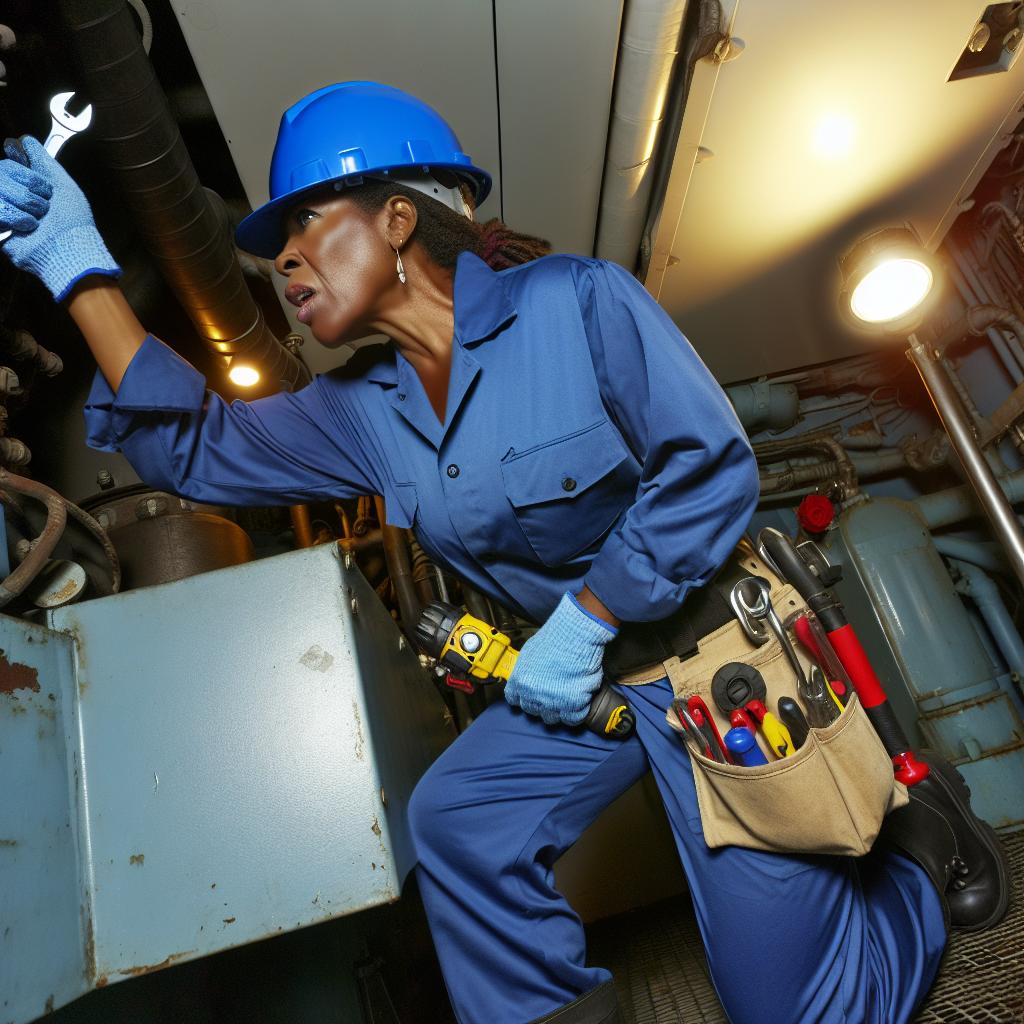Introduction:
As a maintenance worker, handling emergency repairs quickly and efficiently is crucial to prevent further damage to the property and ensure the safety of occupants.
Common types of emergency repairs include plumbing leaks, electrical issues, and HVAC problems.
Assess the Situation:
When faced with an emergency repair, it is important to first assess the situation to determine the extent of the damage and the best course of action.
This will help you prioritize tasks and allocate resources effectively.
Act Swiftly:
Time is of the essence when it comes to emergency repairs.
Act swiftly to address the immediate issue and prevent it from escalating further.
Communicate with your team members and establish a plan of action to expedite the repair process.
Gather Necessary Tools and Materials:
Before starting the repair, make sure you have all the necessary tools and materials on hand.
This will help prevent delays and ensure that the repair is completed in a timely manner.
Organize your tools and equipment for easy access during the repair process.
Keep Safety a Top Priority:
While handling emergency repairs, it is important to prioritize safety at all times.
Follow proper safety protocols and guidelines to prevent accidents or injuries.
Provide appropriate protective gear for yourself and your team members to minimize risks during the repair process.
Communicate with Stakeholders:
During emergency repairs, keep stakeholders such as property owners, tenants, and management informed about the situation.
Provide regular updates on the progress of the repair and any potential disruptions.
Clear communication helps manage expectations and build trust with stakeholders.
Follow Up and Document:
After completing the emergency repair, follow up with stakeholders to ensure that the issue has been resolved satisfactorily.
Document the repair process, including any challenges faced and lessons learned.
This information can be valuable for future reference and continuous improvement.
Effective Emergency Repair Strategies:
Handling emergency repairs effectively requires quick decision-making, coordination with team members, and commitment to safety.
Transform Your Career Today
Unlock a personalized career strategy that drives real results. Get tailored advice and a roadmap designed just for you.
Start NowBy following these steps, maintenance workers can respond to emergencies promptly and minimize the impact on the property and its occupants.
Always prioritize safety
– Emphasize the importance of assessing the situation for any potential hazards before beginning repairs.
– Provide examples of safety precautions to take, such as wearing protective gear and shutting off power if necessary.
Assess the situation
Before diving into emergency repairs, it’s critical to assess the situation at hand.
Look for any potential hazards that could jeopardize your safety or the safety of others.
Identifying risks such as electrical hazards, gas leaks, structural damage, or hazardous materials should be your first step before proceeding with the repairs.
Communication is key
Once you’ve assessed the situation, it’s essential to communicate with your team or supervisor about the emergency repairs that need to be addressed.
Keeping everyone in the loop ensures that the necessary resources and support are available to handle the repairs swiftly and efficiently.
Prepare your tools and equipment
Before starting the emergency repairs, make sure you have all the necessary tools and equipment readily available.
Having the right tools on hand will not only streamline the repair process but also prevent any unnecessary delays that could compromise the safety of others.
Follow safety protocols
When it comes to emergency repairs, safety should always be your top priority.
Follow safety protocols and guidelines diligently to prevent any accidents or injuries.
Wearing appropriate protective gear, such as gloves, goggles, and helmets, can safeguard you against potential hazards that may arise during the repair process.
Shut off power if necessary
If the emergency repair involves electrical components, it’s crucial to shut off the power supply before starting any work.
Turning off the power not only protects you from electric shocks but also prevents further damage to the electrical system that could worsen the situation.
Work efficiently but cautiously
While it’s important to work quickly to address the emergency repair, rushing through the process can compromise safety.
Take your time to ensure that each step of the repair is done correctly and cautiously to prevent any accidents or mistakes that could lead to further damage.
Seek assistance if needed
If you encounter a repair that is beyond your expertise or requires additional support, don’t hesitate to seek assistance from a more experienced maintenance worker or supervisor.
It’s better to ask for help and address the repair effectively rather than attempting to handle it on your own and potentially making the situation worse.
Document the repairs
After completing the emergency repairs, make sure to document the process, including any challenges faced, solutions implemented, and any follow-up steps required.
Transform Your Career Today
Unlock a personalized career strategy that drives real results. Get tailored advice and a roadmap designed just for you.
Start NowKeeping a detailed record of the repairs not only helps in future reference but also allows for a better understanding of how to handle similar emergencies in the future.
Learn from the experience
Every emergency repair presents a valuable learning opportunity to improve your skills and knowledge as a maintenance worker.
Reflect on the repair process, identify areas for improvement, and implement any lessons learned into your future repair work to enhance your efficiency and effectiveness.
Quickly assess the issue
Identifying the root cause swiftly is crucial to prevent further damage.
Check for obvious signs of malfunction to pinpoint the issue accurately.
Use diagnostic tools if necessary to aid in troubleshooting the problem.
Prioritize safety when assessing emergency repairs to avoid accidents.
Collaborate with team members to expedite the assessment process.
Explain the importance of quickly identifying the root cause of the problem
Swift identification prevents escalation of minor issues into major repairs.
Saves time and resources by addressing the core problem promptly.
Improves overall maintenance efficiency and reduces downtime for repairs.
Enhances resident or employee satisfaction by resolving issues promptly.
Minimizes the risk of further damage to the property or equipment.
Provide tips on how to troubleshoot common emergency repair issues effectively
Create a checklist of common issues and their troubleshooting steps.
Conduct regular training sessions on emergency repair procedures.
Utilize technology such as mobile apps for quick access to repair guides.
Keep essential tools and spare parts readily available for emergencies.
Develop a system for documenting repair steps and outcomes for future reference.
Find Out More: Warehouse Worker Job Description and Duties Explained
Effective Communication is Key
Communication is essential when handling emergency repairs as a maintenance worker.
Transform Your Career Today
Unlock a personalized career strategy that drives real results. Get tailored advice and a roadmap designed just for you.
Start NowHere are some key points to keep in mind:
Stress the Importance of Clear Communication
- Clearly convey details about the repair issue to team members and supervisors.
- Ensure that everyone understands the urgency and scope of the repair task.
- Use simple and concise language to avoid any misunderstandings.
- Provide updates on the progress of the repair work to keep everyone informed.
Benefits of Teamwork and Coordination
- Working together as a team can make handling urgent maintenance tasks more efficient.
- Each team member can contribute their skills and expertise to solve the problem effectively.
- Coordination ensures that tasks are allocated effectively and completed in a timely manner.
- Teamwork fosters a sense of collaboration and support among colleagues.
By emphasizing clear communication and the benefits of teamwork, maintenance workers can effectively handle emergency repairs and ensure that the job is done efficiently and professionally.
Learn More: Health and Safety Tips for Aspiring Lumberjacks
Have a well-stocked toolkit
When it comes to handling emergency repairs as a maintenance worker, having a well-stocked toolkit is crucial.
Here are some essential tools and equipment that maintenance workers should have on hand for emergency repairs:
- Screwdriver set: This includes flathead and Phillips head screwdrivers in various sizes.
- Adjustable wrench: Useful for tightening or loosening nuts and bolts of different sizes.
- Pliers: A versatile tool that can be used for gripping, cutting, bending, and twisting wires.
- Tape measure: Essential for taking measurements accurately for repairs and installations.
- Utility knife: Handy for cutting materials like packaging, cardboard, plastic, and more.
Creating a portable toolkit
To ensure you have the right tools when you need them, consider creating a portable toolkit that can be easily carried to different job sites.
Here are some recommendations for putting together a compact and efficient toolkit:
- Choose a durable and lightweight toolbox or tool bag to store your tools.
- Organize your tools in compartments or pouches for easy access and quick identification.
- Keep only essential tools that you use frequently to avoid carrying unnecessary weight.
- Include spare parts like screws, nails, washers, and other common hardware items.
- Consider investing in a cordless drill with extra batteries for faster and more efficient repairs.
By having a well-stocked toolkit and a portable set of essential tools, maintenance workers can effectively handle emergency repairs in any situation.
Gain More Insights: Landscape Architecture: Key Challenges and Solutions
Prioritize temporary fixes if needed
When facing emergency repairs as a maintenance worker, it is crucial to prioritize temporary fixes to address immediate issues and prevent further damage.
Temporary solutions can help keep buildings secure and functioning until a permanent repair can be made.
Importance of implementing temporary solutions
- Temporary fixes provide a quick way to address urgent problems and minimize downtime.
- They help prevent safety hazards and protect the integrity of the building structure.
- Temporary solutions can buy time for thorough assessment and planning of permanent repairs.
For example, in the case of a leaking pipe, applying a temporary sealant can stop the water flow and prevent water damage to the surrounding area.
This quick fix can help avoid extensive repairs and costly replacements.
Examples of temporary fixes
- Using duct tape to temporarily patch a leaking roof or pipe.
- Placing buckets under a leaking ceiling to collect water until proper repairs can be made.
- Installing temporary barriers or signage to warn occupants of hazardous conditions.
Maintenance workers should always be prepared to implement temporary fixes in emergency situations to ensure the safety and security of the building and its occupants.
Learn More: Top Landscape Architecture Programs in the US

Document the Repair Process
It’s crucial to document each step of the emergency repair process to maintain a clear record.
Keeping detailed records can be beneficial for future reference and reporting purposes.
Documenting the repair process ensures that valuable information is not lost or forgotten.
By documenting each step, you create a roadmap for future repairs or maintenance on the same issue.
Having accurate records of past emergency repairs can help identify patterns or recurring issues.
Transform Your Career Today
Unlock a personalized career strategy that drives real results. Get tailored advice and a roadmap designed just for you.
Start NowDetailed documentation can also be useful for training new maintenance workers in handling emergency repairs.
If a similar emergency occurs in the future, detailed records can speed up the repair process.
By documenting the repair process, you contribute to establishing best practices for handling emergency repairs.
Detailed records can also be used to analyze the effectiveness of different repair methods over time.
The documentation of repair processes can be essential for compliance with regulatory requirements and standards.
Follow up on completed repairs
After completing emergency repairs, it is crucial to follow up with building occupants or supervisors to ensure satisfaction.
- Stress the importance of communication
- Check for any potential issues
- Address any future concerns
- Provide feedback channels
- Document the follow-up process
It is essential to communicate with those affected by the issue and let them know that repairs have been completed.
Make sure to inspect the area thoroughly to ensure that the problem has been completely resolved.
Take the time to anticipate any potential issues that may arise in the future and address them proactively.
Encourage occupants to provide feedback on the repairs and any additional concerns they may have.
Keep detailed records of the follow-up process to track the effectiveness of the repairs and identify any recurring issues.
Handling Emergency Repairs in Maintenance
Handling emergency repairs as a maintenance worker requires quick thinking.
Effective problem-solving skills are crucial in these situations.
It is essential to prioritize safety during emergency repairs.
Clear communication with the team is equally important.
Assessing the situation before taking action is necessary.
By being prepared and proactive, maintenance workers can ensure safety.
They also maintain the functionality of buildings and equipment.
Staying calm and focused in a crisis is vital.
This calmness can make a significant difference in handling repairs effectively.
Transform Your Career Today
Unlock a personalized career strategy that drives real results. Get tailored advice and a roadmap designed just for you.
Start NowAdditional Resources
Field Operations Handbook – Chapter 15 | U.S. Department of Labor
General Maintenance and Repair Workers : Occupational Outlook …




